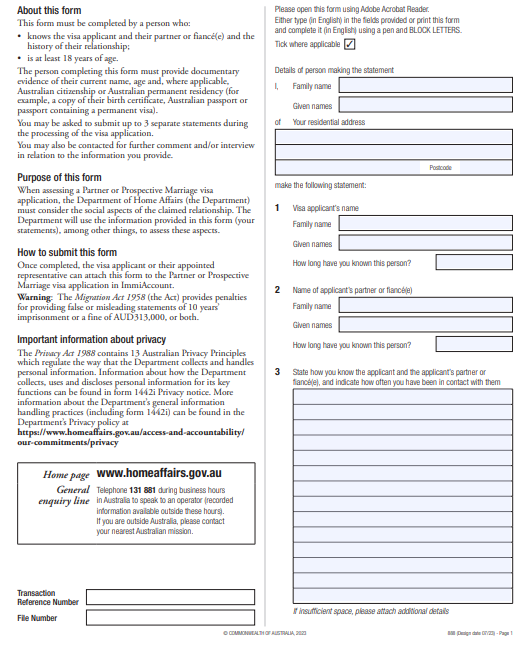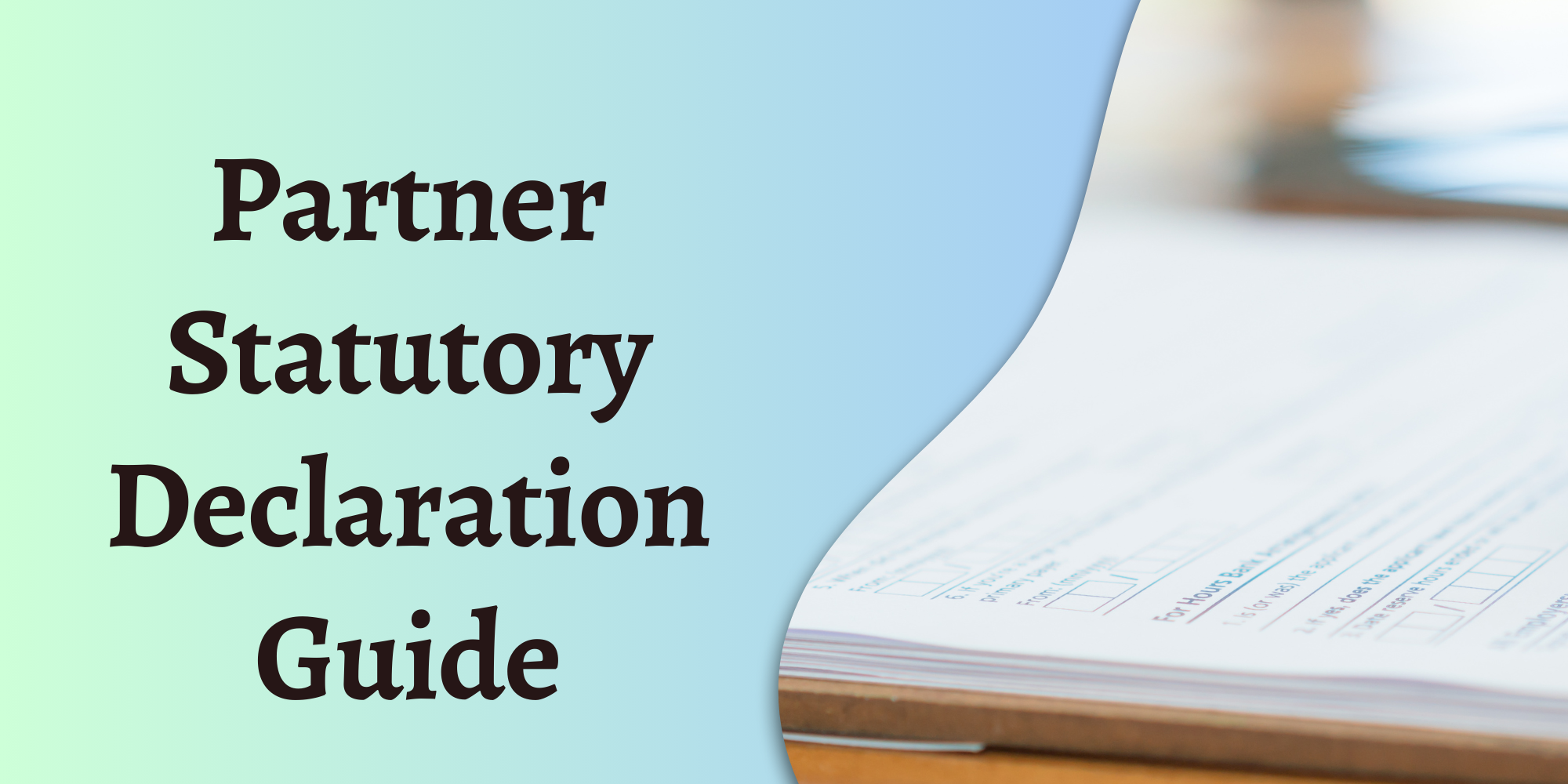A partner statutory declaration is an important document in legal proceedings since it is frequently required to prove the validity of a connection between partners. This declaration is important for presenting evidence of a true partnership in immigration applications, financial transactions, and legal agreements.
This article aims to delve into the intricacies of partner statutory declarations, and their importance, and provide a detailed example to assist individuals in drafting their own declarations effectively.
A partner statutory declaration is a formal document wherein one partner attests to the authenticity of their relationship with another. This declaration is commonly sought in various situations, including:
- Immigration Applications: Particularly in cases where one partner is sponsoring the other for immigration or visa purposes, immigration authorities often require a partner statutory declaration to validate the relationship.
- Financial Transactions: When partners are applying for joint loans, mortgages, or other financial agreements, financial institutions may request a partner statutory declaration as evidence of their partnership.
- Legal Agreements: In the context of legal contracts or agreements, such as cohabitation agreements or partnership contracts, partners may need to provide a statutory declaration to establish their relationship status.
Importance of Partner Statutory Declarations
Partner statutory declarations play a crucial role in various legal processes for several reasons:
- Verification of Relationship Authenticity: These declarations serve as concrete evidence of the existence and authenticity of a partnership, providing assurance where documentary evidence may be lacking.
- Compliance with Legal Requirements: Many legal proceedings necessitate proof of a genuine relationship, and partner statutory declarations fulfil this requirement, ensuring compliance with relevant laws and regulations.
- Prevention of Fraud: By requiring partners to make sworn statements regarding their relationship, statutory declarations help deter fraud or misrepresentation in legal and administrative contexts.
Components
A partner statutory declaration typically includes the following components:
- Personal Information: Full names, addresses, dates of birth, and other relevant personal details of both partners.
- Statement of Truth: A declaration by the partner making the statement, affirming the accuracy and truthfulness of the information provided.
- Description of Relationship: Details regarding the commencement of the relationship, cohabitation, joint responsibilities, and other relevant information.
- Witness Testimony: A statement from a witness who can verify the truthfulness of the declaration and the legitimacy of the relationship.

Partner Statutory Declarations Categories
Relationship Development
This segment details the progression of your relationship from its inception, including:
- Introduction Method: How you and your partner were initially introduced, whether through mutual acquaintances, family connections, or an online dating platform.
- Initial Contact: The date and method of your first communication, whether it was via text message, a phone call, or an in-person meeting.
- First In-Person Meeting: The date and location of when you and your partner first met face-to-face.
- Key Milestones: Notable events, vacations, or personal challenges you faced that led to your decision to commit to an exclusive relationship.
- Cohabitation: The lead-up to you and your partner deciding to live together.
- Supportive Moments: Significant times in your relationship when you provided each other with support, including during illness, work-related stress, or adapting to life changes such as moving to Australia.
Household Dynamics
This section explores your joint responsibilities within your household, including:
- Household Chores: Distribution of tasks such as cleaning, cooking, and shopping.
- Childcare Responsibilities: How both partners contribute to the care of any children from the relationship.
- Additional Household Duties: Responsibilities related to pets, elder care, or other family needs.
Social commitments
Discuss the social dimensions of your relationship, such as:
- Joint Holidays: Shared vacations and trips.
- Attended Events: Participation in weddings, baptisms, and significant social gatherings.
- Community of Support: Friends and family who are aware of and support your relationship.
- Shared Activities: Engagement in sports, cultural events, or other shared interests.
Financial aspects of your relationship
In this section, detail your shared financial responsibilities and agreements, including:
- Joint Financial Agreements: Shared loans or leases, such as those for your home, vehicles, or business.
- Joint Banking: The use of a shared bank or savings account for regular transactions.
- Business Partnerships: Any business ventures you own or operate together.
- Financial Benefits for Each Other: Naming your partner as a beneficiary in wills or insurance policies.
- Household Expense Management: How you both contribute to and manage day-to-day expenses.
- Income Management: If both partners’ incomes are deposited into the shared account.
- Future Financial Plans: Goals for saving for a home purchase, wedding expenses, or travel.
- Significant Purchases: Joint acquisition of major assets or household items.
Your Commitments to Each Other
This section should articulate your mutual commitment, illustrated by:
- Future Plans: Intentions for purchasing property, starting a family, or upgrading your living situation post-arrival in Australia.
- Affirmation of Your Relationship: A statement affirming the genuine and committed nature of your partnership.
Reference to Supporting Documents
When drafting your statutory declaration, referring back to uploaded supporting documents can significantly bolster your statements by:
- Provide tangible evidence of your relationship’s development, shared financial responsibilities, household dynamics, social engagements, and commitment to each other. This approach lends credibility to your narrative and assists the case officer in verifying the authenticity of your partnership.
To illustrate the process of drafting a partner statutory declaration, let’s examine a detailed example:
Partner Statutory Declaration Example
I, [Partner A’s Full Name], residing at [Partner A’s Address], born on [Partner A’s Date of Birth], solemnly and sincerely declare as follows:
- I am in a genuine and committed relationship with [Partner B’s Full Name], residing at [Partner B’s Address], born on [Partner B’s Date of Birth].
- Our relationship commenced on [date of commencement], and we have been cohabitating since [date of commencement].
- We share joint responsibilities, including household expenses, and have intermingled our finances by maintaining a joint bank account.
- I confirm that all information provided in this declaration is true and accurate to the best of my knowledge and belief.
I make this solemn declaration conscientiously, believing the same to be true and by virtue of the provisions of the Statutory Declarations Act [Jurisdiction], on this [date] at [location].
Declared at [Location] on [Date]
Witnessed by:
Conclusion
Partner statutory declarations serve as indispensable tools in various legal contexts, offering evidence of the authenticity of relationships. Understanding their significance and knowing how to draft them effectively is essential for individuals navigating immigration processes, financial transactions, or legal agreements with their partners. By providing a detailed example and comprehensive insights, this article aims to empower individuals to craft their partner statutory declarations confidently, ensuring compliance with legal requirements and facilitating smoother proceedings in their endeavours.
Disclaimer: The above information is a general guide and not professional immigration advice. Be aware that immigration laws and regulations can change swiftly, potentially rendering some or all of the information outdated. Thus, before using the information above, we recommend checking the current laws with assistance from a migration agent or the Department of Home Affairs website.

